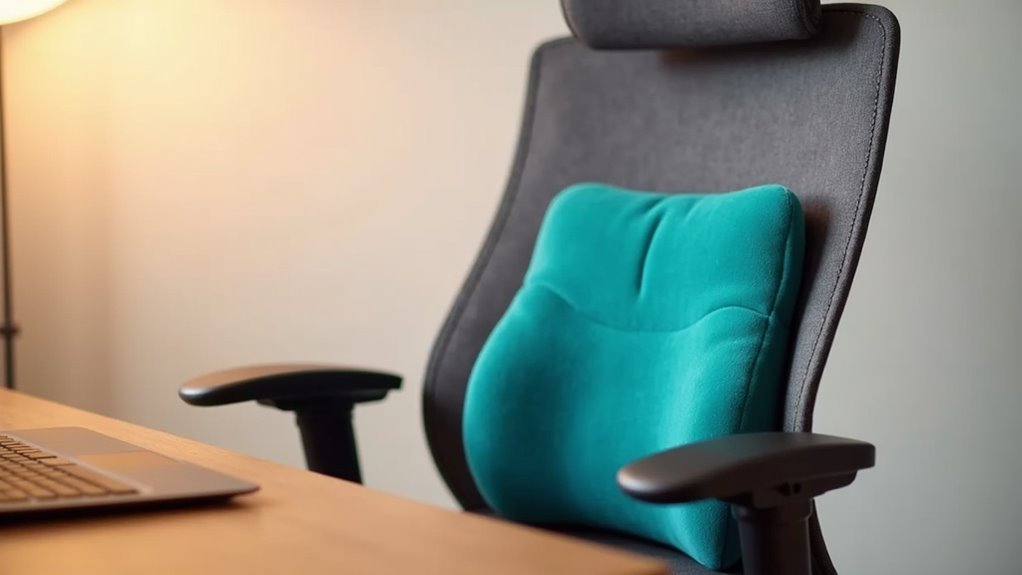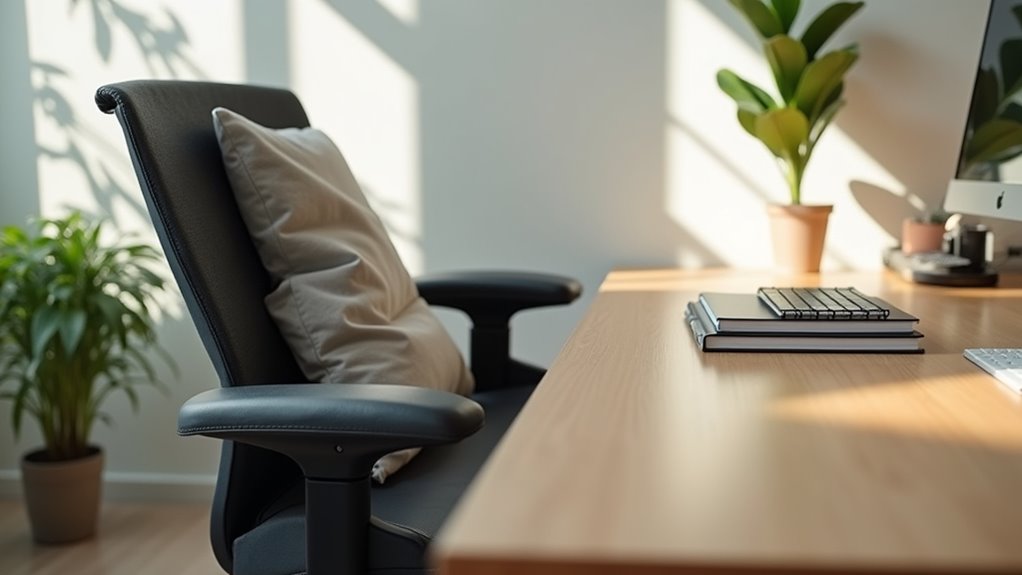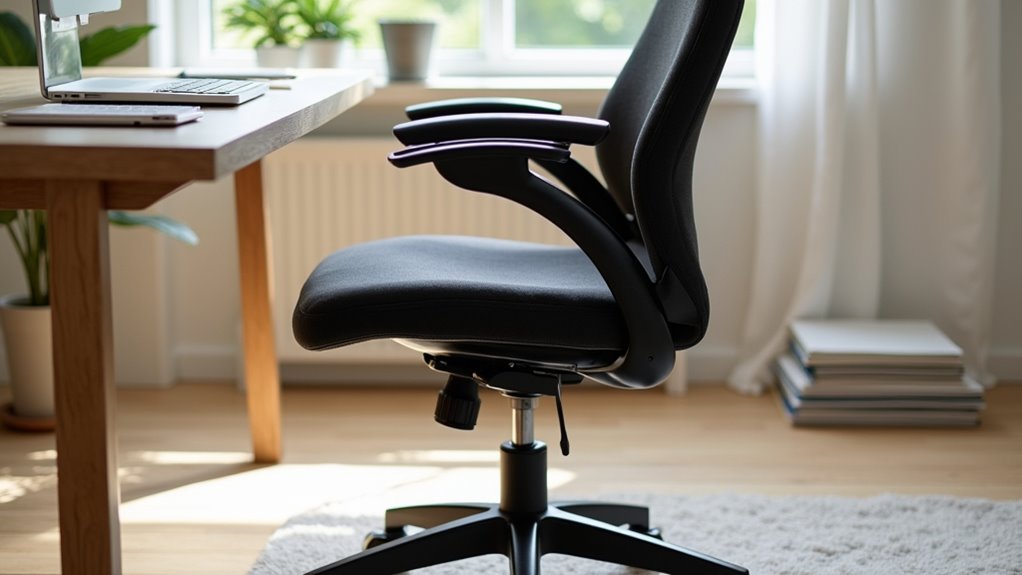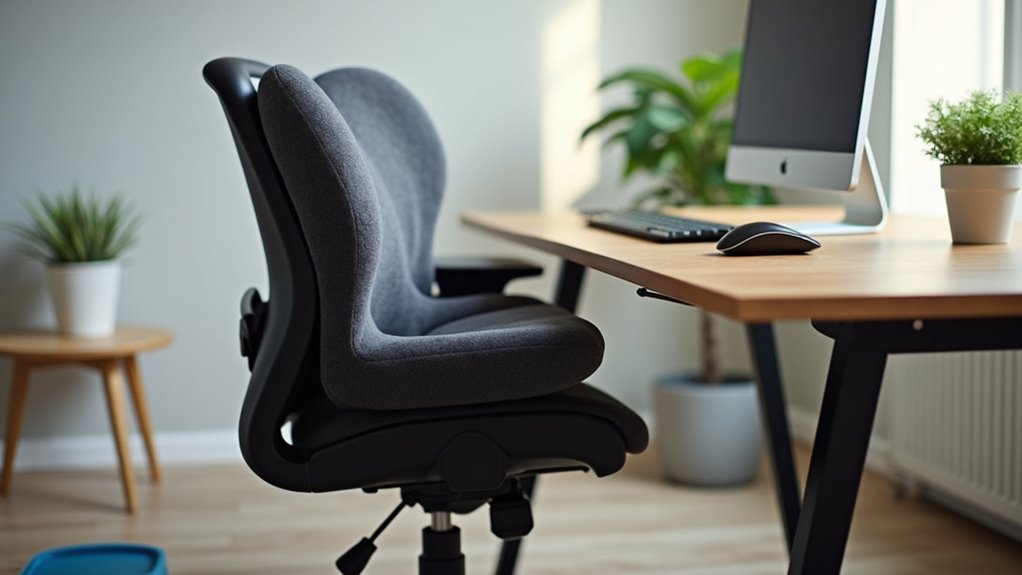How to Make a Desk Chair More Comfortable
This post contains affiliate links. As an Amazon Associate, we earn from qualifying purchases.
To enhance the comfort of your desk chair, adjust the height so your feet touch the floor, aiming for a 90-degree angle with your legs. Incorporate lumbar support to maintain a straight back and select a seat cushion that suits your needs. Ensure the armrests are at elbow height to promote relaxed shoulders, and consider adding a footrest for extra support. These straightforward adjustments will significantly improve your sitting experience, and further details will be provided later for those seeking a deeper understanding.
Essential Facts in 30 Seconds
- Adjust chair height for flat feet and knees slightly lower than hips.
- Incorporate lumbar support for spine curve and to prevent slouching.
- Use a body-shaped seat cushion that fits your chair.
- Position armrests for elbows at a 90-degree angle to reduce shoulder tension.
- Utilize a footrest to elevate feet and relieve thigh pressure.
Adjusting the Chair Height
Adjusting your chair height makes your desk setup more comfortable.
Start by standing up. Measure from the floor to the bottom of your kneecap. This helps you find the right chair height.
Sit down. Your feet should touch the floor. If they don’t, use a footrest. Your knees should be a bit lower than your hips. Aim for a 90-degree angle for your legs. Proper office ergonomics can significantly enhance your overall comfort while working. Ensuring that your chair height is stable and comfortable provides optimal support for your body. A well-adjusted chair height is crucial for maintaining good posture throughout the day, as it reduces strain on your back and neck.
To change the height, find the lever on the right side of the chair. Pull the lever up to raise the chair while standing. To lower the chair, stay seated and pull the lever down. The top of the seat should be just below your kneecap, allowing for optimal comfort during prolonged sitting.
With these simple steps, you can enjoy a comfy and supportive sitting experience.
Enjoy your cozy workspace!
Adding Lumbar Support

Once your chair height is just right, focus on lumbar support. This support keeps your lower back happy and healthy. Poor support can cause slouching and back pain. The lumbar support naturally curves your spine, promoting better posture. Proper ergonomics is essential for preventing long-term health issues. Additionally, maintaining proper sitting posture can greatly enhance your overall comfort while seated. Regularly adjusting your lumbar support can help alleviate strain on your back as you sit for extended periods. Explore some easy options for better comfort.
Here’s a quick guide to help you choose:
| Type of Support | Description | Ideal For |
|---|---|---|
| Lumbar Rolls | Cylindrical cushions that fit your lower back | Budget-friendly solution |
| Adjustable Cushions | Customizable firmness for personal comfort | Tailored support |
| Built-in Adjustables | Ergonomic features that move with you | Dynamic posture changes |
Try a lumbar roll or an adjustable cushion. Place it to align with the curve of your spine. Comfort is key. Find what feels right for you. Enjoy your sitting experience!
Choosing the Right Seat Cushion
Choosing the right seat cushion can turn your desk chair into a comfy throne.
Start by considering materials. Foam offers a nice balance of comfort and durability. Memory foam molds to your shape but can feel warm. Gel cushions are also available for added comfort. Breathable materials like mesh can also enhance overall comfort during long sitting sessions. Additionally, proper height of the chair and cushion combination is essential to prevent discomfort. Maintaining the right chair height aids blood circulation and reduces thigh pressure. Regular maintenance, such as vacuuming fabric chairs, can also prolong the life of your cushion.
Next, look at shapes. S-shaped and U-shaped cushions support your hips and lower spine. They help you sit up straight and feel good.
Fit matters too. A cushion that’s too big or too small can cause discomfort.
Spills happen, so a removable cover is a smart choice. It makes cleaning easy.
Pick a cushion that matches your style and needs. Enjoy your new throne!
Utilizing Armrests Properly

Armrests are key for a comfy desk setup. Set them at the right height. Keep your shoulders relaxed.
Your elbows should form a cozy 90-degree angle. This simple adjustment helps a lot. It keeps you comfy and prevents shoulder strain. Incorporating adjustable features in your chair can further enhance your comfort during long hours. Properly positioned armrests can also reduce shoulder tension and improve overall posture. Additionally, fixed armrests provide stable support that can enhance comfort during extended work sessions.
Small changes can make a big difference. Use your armrests well to stay relaxed while you work.
Enjoy a better work experience today!
Optimal Arm Height Adjustment
Adjusting your armrests can greatly improve your comfort while working at your desk. Start by setting the armrests to match the height of your desk. Your forearms should rest easily, with elbows bent at about 90 degrees. A properly adjusted chair can also prevent sinking issues that may arise over time.
Armrests that are too high or too low can cause bad posture and strain. This can lead to discomfort over time. Proper adjustment of armrests supports good ergonomic posture. This helps you work without pain and reduces strain on back and neck muscles.
Move the arm pads closer or farther apart to suit your shoulder width. If the armrests don’t fit well, consider removing them. Regularly inspecting your chair for signs of wear can help maintain its usability and comfort.
Keep your arms relaxed for the best support. Taking breaks every 30-60 minutes can also enhance your overall comfort and reduce fatigue. Take time to adjust your workspace. Your body will feel better for it!
Elbow Positioning Importance
Working comfortably at your desk is all about elbow positioning. Proper alignment makes a big difference. Check out this simple table to understand more:
| Elbow Position | Benefits | Strain Reduction Techniques |
|---|---|---|
| Close to torso | Reduces strain on the back | Use armrests for support |
| 90-degree angle | Lowers tension on tendons | Adjust the desk to fit your height |
| Relaxed position | Less muscle fatigue | Keep wrists straight and relaxed |
Follow these tips for a more comfortable workspace. Good elbow positioning helps you feel better while you work. Additionally, ensure you utilize armrest settings properly to enhance overall comfort while typing or resting. Incorporating proper body positioning can further contribute to reducing discomfort during long hours at your desk. Remember that maintaining good health through correct sitting posture is essential for productivity and overall well-being.
Arm Support and Relaxation
Setting up your elbows is just the start. Arm support is very important! Good armrests keep your shoulders relaxed and your arms comfortable.
Adjustable armrests are best. They should fit under your elbows, keeping your shoulders neutral. This helps your arms rest naturally and reduces strain.
Soft armrests, like those made of memory foam, feel great! You won’t have sore elbows anymore.
Well-placed armrests make a big difference. They help prevent fatigue during long hours at your desk. Additionally, proper sitting posture can enhance your overall comfort and productivity.
Adjust those armrests properly, and you can work comfortably. Enjoy a pain-free experience while you focus! That’s a great benefit!
Incorporating Footrests

A footrest can make your desk chair even cozier. It gives your feet a nice break while you work. Here’s how to choose the right one and set it up perfectly.
First, consider the height of the footrest. It should raise your feet a few inches off the ground. Your knees should sit lower than your hips. This keeps your legs comfortable and helps your back.
Next, think about the material. A soft, cushioned footrest feels great. Look for one that supports your feet well. Some footrests even have adjustable angles. This feature lets you find the best position for you.
Place the footrest under your desk. Your feet should rest easily on it. Keep your heels on it while your toes can stay on the ground. This position helps reduce strain on your legs.
Try using the footrest for a few days. Notice how it feels. You might find it helps you focus better. A comfy setup can make work more enjoyable.
Kick those feet up and enjoy the comfort of a footrest at your desk!
Benefits of Footrests
Using a footrest can greatly improve your comfort while sitting. It makes any desk chair feel better.
There are many types of footrests to choose from, like adjustable or cushioned ones. Pick the one that suits you best. The materials matter too. Foam or wood can change how cozy you feel.
A footrest helps reduce pressure on your thighs. This can improve your posture. Good posture keeps you sitting upright and focused. You’ll feel less tired and more creative when you’re comfortable. It can even lift your mood!
Proper Footrest Height
A comfy footrest is just the beginning of a great desk chair experience. Getting the height right is crucial. Your feet should rest flat on the footrest. Heels need full support. Aim for a height that keeps your knees bent at about 90 degrees or slightly more open. Most footrests are between 4 to 6 inches high. Adjustable footrests let you find your perfect fit.
To measure correctly, use a tape measure from your sitting knee height to the floor.
The right footrest materials matter too. Look for non-slip surfaces for stability and comfort. Keeping your feet from dangling improves circulation and posture. Happy legs lead to better work!
Selecting the Right Footrest
Choosing the right footrest makes your desk chair more comfy.
Start by thinking about footrest types. Integrated retractable footrests save space. Separate footrests give you more comfort and adjustment options. Split footrests let you position each foot perfectly. One-piece footrests keep things simple.
Next, look at footrest features. Adjustable height and tilt settings help you find the best position. Anti-slip feet prevent slips, keeping you safe. Cushioning adds comfort, especially during long hours at your desk.
Portability matters too. A lightweight footrest is easy to move around.
Pick the right one, and your feet will feel great!
Maintaining Proper Posture

Sinking into your chair can feel nice, but good posture matters. Adjust your seat height so your feet stay flat on the floor. This keeps your legs comfortable and blood flowing.
Sit back in your chair to use the back support. This helps keep your spine straight and reduces slouching.
Your arms also need attention. Keep your elbows close to your body, around 90 degrees. Adjust the armrests if needed.
Position your monitor at eye level. This prevents neck strain.
Take breaks to stretch and move around. Your body will feel better. Regular movement allows the body to recharge and stay engaged.
Stand tall like a superhero. Your back will thank you!
Frequently Asked Questions
How Often Should I Take Breaks While Sitting?
Take breaks every 30 minutes. Stand up or move around for 3 to 5 minutes. This helps your posture and reduces discomfort. It also boosts your health when sitting for long times. Regular movement keeps your muscles active and blood flowing. Remember, staying still for too long can lead to stiffness and pain. Simple stretches or a quick walk can make a big difference. So, set a timer as a reminder. Your body will thank you!
What Are Signs My Chair Is Not Ergonomic?
A chair without good lumbar support can harm your posture. Poor adjustments can lead to discomfort and tiredness. Watch for signs like slouching or pain in your back. These indicate your chair is not ergonomic. Pay attention to these issues. An ergonomic chair should support your body well. Proper support keeps you comfortable and focused.
Can I Use My Chair for Extended Periods?
Using your chair for long hours is possible. Make some ergonomic adjustments first. Good chair cushions can help too. These changes improve your posture and comfort. They also reduce fatigue when sitting for a long time. Remember to take breaks. Stand up and stretch regularly. Small movements help keep your blood flowing. Drink water to stay hydrated. Simple steps can make a big difference. Enjoy your time in the chair!
How Do I Clean and Maintain My Ergonomic Chair?
To clean and maintain your ergonomic chair, follow these simple tips. Start by using a microfiber cloth to wipe down the upholstery. This keeps it free from dust and dirt. Next, use a vacuum to get rid of any loose particles. Pay special attention to the creases and corners. If you spot a stain, clean it right away. Use a gentle cleaner or soap with water. Avoid harsh chemicals that can damage the fabric.
Check the chair’s wheels and base regularly. Remove any hair or debris that gets caught. Tighten screws or bolts if they become loose. This helps keep your chair stable and safe. Finally, adjust the chair to fit your body properly. This prevents strain and keeps you comfortable. Taking care of your ergonomic chair helps it last longer and stay functional.
What Should I Look for When Buying a New Chair?
Buying a new chair? Focus on adjustable features. They help you find a perfect fit. Check the material too. Good quality means more comfort and durability. Choose a chair that supports your back. This helps your posture. Think about your workspace. The right chair can make a big difference in how you feel while working. Always test the chair before you buy. Sit in it for a few minutes. Feel how it supports you. A good chair is an investment in your health and comfort.
Conclusion
Now that you have these tips, imagine yourself sitting in a comfy chair. Adjust the height. Add cozy lumbar support. Choose the right cushion. These steps make your chair feel like a throne.
Use armrests and footrests, too. They help you relax even more. Good posture is key. It helps you focus on your tasks.
Make those changes and enjoy your workspace. Your chair can be awesome!
